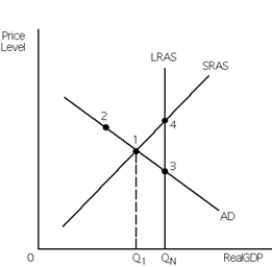Exhibit 9-6
 -Refer to Exhibit 9-6. If the economy is self-regulating and currently at point 1, what is going to happen?
-Refer to Exhibit 9-6. If the economy is self-regulating and currently at point 1, what is going to happen?
A) Wages rise, the SRAS curve shifts to the right until it passes through point 3; in long-run equilibrium the price level is lower and Real GDP is higher than at point 1.
B) Wages fall, the SRAS curve shifts to the left until it passes through point 2; in long-run equilibrium the price level is higher and Real GDP is lower that at point 1.
C) Wages fall, the SRAS curve shifts to the right until it passes through point 3; in long-run equilibrium the price level is lower and Real GDP is higher than at point 1.
D) Wages rise, the AD curve shifts to the right until it passes through point 4; in long-run equilibrium the price level and Real GDP are higher than at point 1.
E) Prices rise, the AD curve shifts to the right until it passes through point 4; in long-run equilibrium the price level and Real GDP are higher than at point 1.
G) C) and D)
Correct Answer

verified
Correct Answer
verified
Which of the following statements is false?
A) The classical economists believed that government should manage the economy.
B) The classical economists believed in a policy of laissez-faire.
C) The classical economists believed that the economy was self-regulating.
D) The classical economists believed equilibrium output would be full-employment output.
F) A) and C)
Correct Answer

verified
Correct Answer
verified